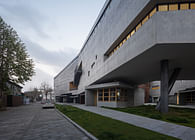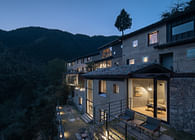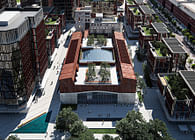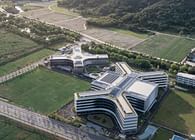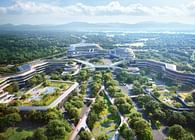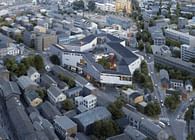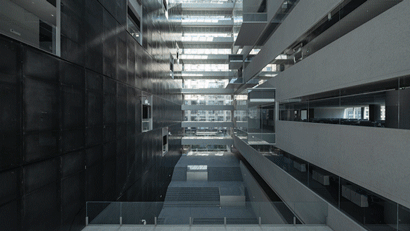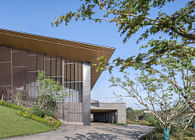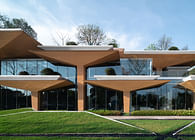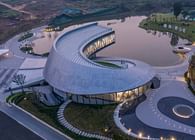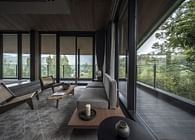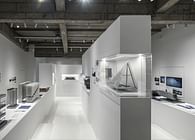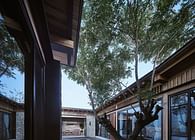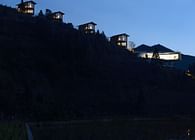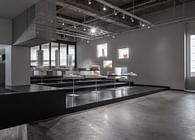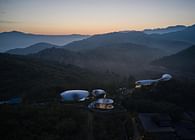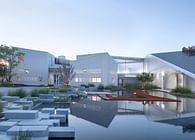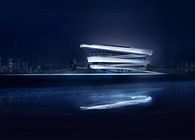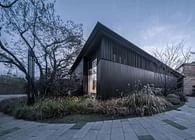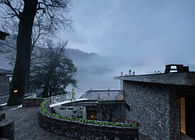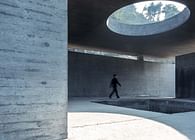
The core of the township revitalization lies not in the replacement of architecture and space, but in the elements that stimulates human vitality: jobs, residence, and the hustle and bustle. In Dingzha, we hope to build a new "urban and rural collaboration" model based on industry introduction and local circulation and combine pre-operation with spatial transformation to create a new hometown in the old town. — Peidong Zhu
Located at the border of Shanghai, Jiangsu and Zhejiang, Dingzha Town where water town SOHO is located has become a hollowed out township after one-way siphon of urban development elements. As the future "Zhejiang Model", Dingzha hopes to be integrated into the test ground of common prosperity with sustainable vitality among the development opportunities of the "Yangtze River Delta integration Demonstration Zone".
In exploring the path of bidirectional balance between urban and rural areas, the revitalization path with cultural tourism as the starting point has been developed successively by the East Gate and West Gate of Wuzhen, which has been widely recognized by the academia, the market and the public. But on the other hand, the vast territory is scattered with those ordinary towns that lack characteristics and recognition in terms of cultural context, natural landscape and historical accumulation. In the face of these ordinary towns, we try to find a new path, integrating research, planning and design, to carry out value cognition, space transformation and content placement on the historical production remains of the town. With industrial renewal as the triggering point, it is hoped to promote the flow of production factors to the towns, and gradually realize the reconstruction of living and ecological scenes.
01 Value Cognition, Granary Space as a Spiritual Coordinate
As an important grain producing area in the Northern Zhejiang Plain Area, built as a granary community in the 1960s, Dingzha is one of the earliest and largest "House Style Warehouse" representatives in New China. Among them, the reserved "Plain Concrete Arch Granary" was the first new granary type in China at that time.
It was used as a setting for the 2016 movie Braving Wind and Waves. The old market town of Dingzha has come back into public view with a dramatized sense of ruins. The old granary, which retains the important marks of the production and development of the Times, has become an Instagram-Worthy Location for movie fans and we-media audiences. With the implementation and promotion of the integration policy of the Yangtze River Delta, this group of gradually forgotten building community has been given new opportunities by The Times.
After the Spring Festival last year, we were invited to visit Dingzha Old Granary recommended by Mr. Zhang Farong, the Project Manager. We were deeply moved by the atmosphere of vicissitudes on site. We immediately reached a consensus on design strategy upon accepting design task offer: we hope to reactivate the "production" function of the granary as the agricultural building through the hard space transformation to the soft content production, reshape the local spiritual coordinates with the base of the agricultural industry, and create a space carrier of the Dingzha spirit and creative life, find emotional resonance for the former town founders, and also provide experience and practice space for the future content producers.
02 Space Transformation, Shared Smart Granary
Based on the innate ecological pattern and acquired industrial basis, it is positioned as the creative settlement of "Water Town SOHO". The overall planning area of the first phase of "Five Creative Cores" plans to cover a total area of 18,285 square meters, includes a group of abandoned granaries and processing space, as well as some traditional residential areas in the north. In the south of the granary cluster, the whole building community has regular texture and clear structure. Given several additions in history, the central grain processing area has been intermingled with residential settlements, forming a collage like texture.
On the basis of a series of screening studies on the historical value, use value and structural safety of the building, according to the existing space pattern and the original functional organization of the granary, we have positioned the central remaining space as a knowledge-sharing meeting room open to all visitors and users in the future, and the southern "House Style Warehouse" granary cluster as a knowledge storage-entrepreneurial office space.
We have used the updating strategy of removing old-linking-intervening-lighting for reconstruction, integrating the single volume of scattered remaining buildings into a complete spatial sequence, forming a three-dimensional garden bearing the functions of reading, recreation and viewing.
Hall-“Siluoqiang”: We set up the rebuilt site of the traditional residence "Siluoqiang" as the main entrances of the park. We have preserved and restored the “Siluoqiang” of the old house and continued its roof characteristics and structural space. The entrance hall formed by removing the enclosure wall symbolizes the spiritual collision between traditional form and contemporary open space. Column feet wrapped in mirror stainless steel sit above the shallow water, presenting a lightweight posture.
Courtyard-"Tiange Water Courtyard" is connected to the Hall: the Courtyard is set around the towering silo. A flow space is nested inside and outside the square and round chambers with short “wind-moving wood curtain” and perforated rust board screen, creating a semi-permeable space. Between mottled silos and ecological rice paddies, it implies a transition between ecology and production, carrying new living scenarios.
Stage-it translates the river stage of the Jiangnan water towns into a modern sense. It is located in the center of the square to radiate the life clusters on the other side of the river to reproduce the life picture of "watching the opera across the water" with the spiritual carrier of traditional towns.
Path-we transform the historical path formed by the addition of the plant into a mountain path formed by a winding exterior staircase and a rooftop walkway. The path spans the undulating remains of the building and several hanging gardens to the observation deck at the top of the silo.
Pavilion-A glass viewing pavilion added above the silo forms the commanding heights of the spiritual coordinates. During the day, it is a homecoming spot for people to look out into the rice paddies, and at night, it will light up the town after the lights are turned on, becoming a beacon of vitality for people who return home.
03 Overlapping of Types, Integrated Micro Updates
In the southern "House Style Warehouse" granary area, on the premise of regular space structure, the landscape and public activity place are reconstructed.
Meanwhile, Tiange Terrace, an agricultural innovation space adjacent to the paddy fields, is added based on the arched elements of the original workshop. The building integrates into the surrounding ecological rice paddies through the scale transition and the green roof.
Both interior and landscape emphasize "micro-intervention". Interior design is not just about the extension of materials, but also the reconstruction of the field spirit.
Here, the design integrates the contemporary elements to rebuild the old building into a multiple space full of possibilities by creating multi-context content.
In terms of design language, the sense of hard design is weakened, and local materials and plants are used to create an "urban wilderness" cultural landscape of water towns by means of "micro-intervention".
Landscape, as a thread running through the buildings, chooses the techniques and concepts of leaving white space and giving way as far as possible, so that the internal and external space of the building is naturally connected, and a more complete space atmosphere is formed.
04 Content Placement, Cognition and Expectation Renewal
At the beginning of 2023, a number of entrepreneurial groups have settled in. Among them, 18 villages in Yaozhuang Town collectively invested 18 million Yuan as a shareholder of the world's leading in vivo micro-robots enterprises, initiating the mutually beneficial cooperation between the village collective capital and high-tech innovation enterprises. Moreover, the first "Starbucks" in Yaozhuang Town has settled in water town SOHO, and the Folk Culture Art Exhibition and the County Government Salon have been launched, renewing the township community's cognition and expectation of Yaozhuang together with the space.
As one of the demonstration achievements of the third anniversary of the "Yangtze River Delta integration", water town SOHO has been visited by the National Development and Reform Commission and the Party and Government Institutions at all levels. Its model and system innovation for promoting urban-rural integration has also become a model for promoting common prosperity and will continue to improve and promote.
Remarks
The practice of Dingzha Water Town SOHO tries to jump out of the traditional rural revitalization model based on "local features". With the support of policies and operations, it has smoothed the two-way flow of urban and rural vitality factors and reintegrated capital, land, human resources and other development factors. Now, water town SOHO Phase I "Smart Granary" has been put into operation and Phase II SOHO and supporting clusters are also in full swing.
As businesses move in and young people return, our initial vague visions seem to be becoming clearer. It is hoped that this old granary endowed with a new mission can provide a fresh and real sample for exploring the road home of urban-rural cooperation, and continue to light up the road of young people to big towns with the light from the "beacon".
Project Information
Project Name: Yangtze River Delta Integration Demonstration Zone: SOHO Wisdom Granary of Dingzha Water Town
Architectural Design: line+studio, (Building 3#,1#), MLA+(Building 4#, 12#)
Interior Design: line+studio, (Building 3#, 4#, 8#-12#), MLA+(Building 5#, 7#)
Landscape Design: line+studio, MLA+
Website:www.lineplus.studio
Contact Email:pr@lineplus.studio
Chief Architect/Design Principal: Peidong Zhu
Design Team: Mingquan Xing, Wangtao Bao, Shengyao Zhao, Ke Gao, Shiqiu Liang, Xiangjun Liu, Wenyu Zhou (Architecture), Jun Zhu, Xiaoxiao Fan, Zhiyi He (Interior), Shangyang Li, Jianbo Jin, Feier Rao, Jun Li, Wenjie Zhang (Landscape)
Client: Jiashan County Yaozhuang Rural Revitalization Development and Construction Co., Ltd.
Project Management Team: Zhejiang Blue City Youdao Construction Management Co., Ltd.
Project Operator: Hangzhou Hongyi Culture Commercial Tourism Development Co., Ltd.
Preliminary Design Cooperation Unit: Hangzhou Ouben Structural Design Office Co., Ltd.(Structure), Hangzhou MJP M&E (Mechanical and Electrical)
Construction Drawing Cooperation Unit: UADI
Landscape Construction Drawing Cooperation Unit: DSA
Location: Jiashan, Zhejiang
Gross Floor Area: 11,824 square meters
Design Period: February 2022-July 2022
Construction Period: May 2022-October 2022
Structure: frame structure, steel structure
Materials: rust board, paint, wood, mirror stainless steel, glass
Photography: Chen Xi Studio, line+
Status: Built
Firm Role: architect,interior designer,landscape designer







